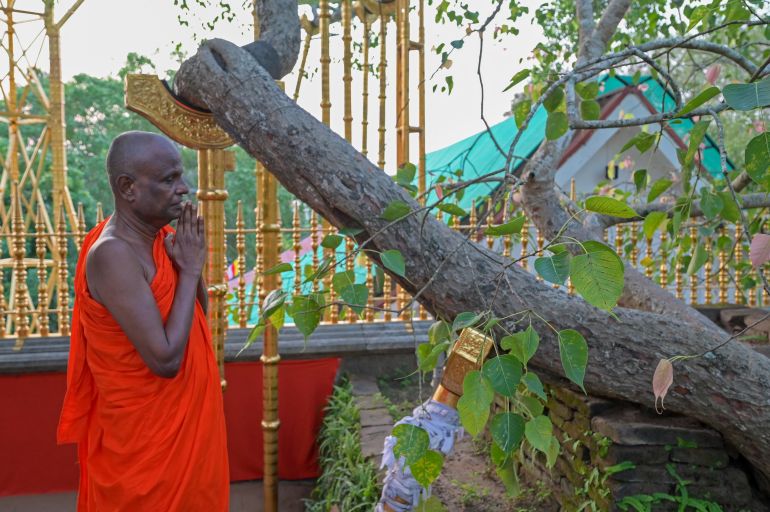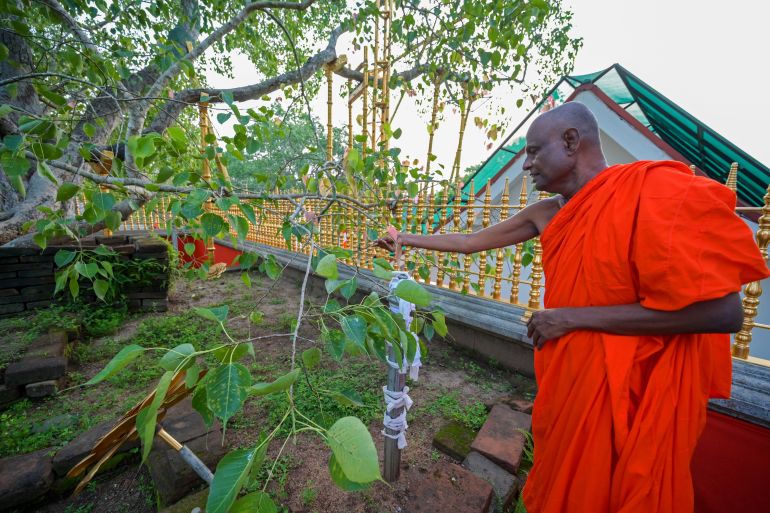Row around Sri Lanka’s holiest tree shows how fake news travels
Posted on June 7th, 2023
Courtesy Aljazeera
Claims of 5G mobile signals harming Sri Maha Bodhi also illustrate the reverence in which the Buddhist-majority country holds the tree.

Published On 7 Jun 20237 Jun 2023
When social media was inundated with rumours that Sri Lanka’s holiest tree was being harmed by 5G mobile signals, Colombo’s cash-strapped government pulled out all the stops.
President Ranil Wickremesinghe dispatched a high-powered team of experts to the 2,300-year-old Sri Maha Bodhi tree in the sacred city of Anuradhapura, an ancient capital of the South Asian island nation.
The team included the head of the telecom regulator, his technical chief and the director of the National Botanical Gardens, along with university professors and district administrators.
Several visits were made, surveys were carried out, and the centuries-old tree was examined and monitored before a conclusion was reached: there were no 5G signals in the area in the first place.

The episode highlighted the speed with which fake news travels in Sri Lanka – but even more so, it illustrated the reverence in which the country holds the Sri Maha Bodhi.
The tree is believed to have been grown from a cutting of the bodhi tree in India that sheltered the Buddha when he attained enlightenment more than 2,500 years ago.
It is both an object of worship and a symbol of national sovereignty on the majority Buddhist island of 22 million people.
‘Great risk’
The first claims it was under threat appeared on a local website: 5G radiation from towers near the tree was supposedly turning its leaves black, and it was at great risk” of eventually shedding them all and dying.
Memes were shared widely on Facebook and WhatsApp groups, and a television presenter repeated the theories on his YouTube channel.
The chief monk of the Bomaluwa Temple that houses the tree in Anuradhapura, 200km (125 miles) north of Colombo, was accused of taking bribes from phone operators to let them set up 5G base stations nearby.
I am not a scientist, nor a botanist, so I raised the issue with the president in February,” monk Pallegama Hemarathana, 68, told AFP news agency. He immediately appointed a panel of experts.”
The government and the Buddhists will do whatever it takes to protect the Sri Maha Bodhi.”

There are four older base stations within 500 metres (1,640 feet) of the tree, but Telecommunications Regulatory Commission Director General Helasiri Ranatunga told AFP there was no 5G coverage in the sacred area as rumoured”.
Radiation in the area was well below World Health Organization thresholds, he said, and botanical experts had ruled there was no threat from existing 2G, 3G or 4G coverage.
The panel did, however, recommend banning mobile phone use to preserve the temple’s tranquillity, he added.
While there are already signs in place to that effect, they are widely ignored by the hordes of visitors to the site.
At the moment, fresh heart-shaped, purple-green leaves are sprouting on the tree.
Botanically a ficus religiosa” – also known as a bo” – the tree is worshipped by thousands of Buddhists daily as a symbol of the living Buddha”.
Comparatively small despite its long history, it is propped up by 10 gold-plated iron supports and dwarfed by another bodhi a short distance away.

First-time visitor G Kusumalatha travelled 400km (250 miles) from Walasmulla with more than 60 other pilgrims to pay homage to the sacred tree.
I feel ecstatic to be so close to the Sri Maha Bodhi,” she said, thanking the good karma” that had given her the opportunity.
But no one is allowed within an arm’s length.
The original tree in India is said to have died centuries ago.
Its Sri Lankan descendant was the scene of an attack in March 1985 by separatist Tamil Tiger rebels, who killed more than 120 people.
Since then, the tree has been provided with airport-style security, with visitors going through metal detectors and pat-downs. It is surrounded by two gold-plated fences and protected round the clock by monks, police and armed troops.
Several men are also deployed to clap their hands and chase away squirrels, birds and monkeys that could threaten the tree.
Sashika Neranjan, 39, visited the site recently with his extended family.
Our sister and brother managed to get permanent residency in Australia after taking a vow here,” he said. We are here to thank the sacred bo tree.”
SOURCE: AFP